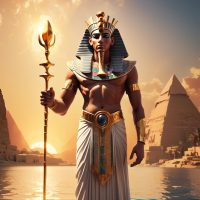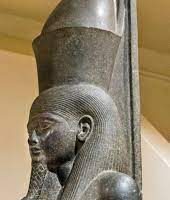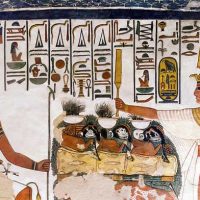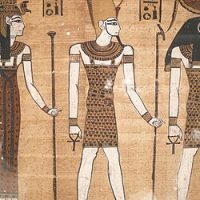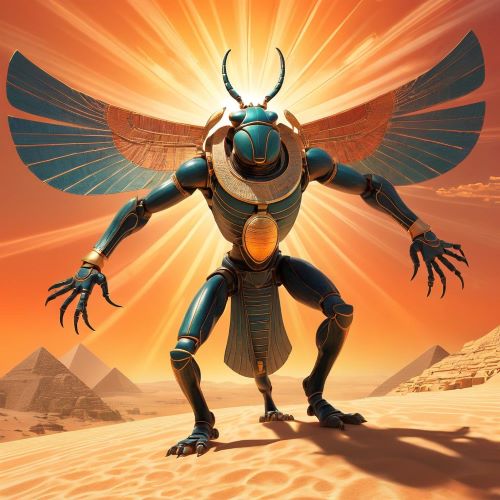Atum : The Creator God
Listen
At a glance
| Description | |
|---|---|
| Origin | Egyptian Mythology |
| Classification | Gods |
| Family Members | Shu, Tefnut (Children) |
| Region | Egypt |
| Associated With | Creation |
Atum
Introduction
Atum stands as one of the most essential and profound deities in Egyptian mythology. Recognized as the self-created god, he is credited with initiating existence from the boundless waters of chaos known as Nun. His emergence marks the beginning of creation and the structuring of the cosmos, a transition from nothingness to life. Atum’s story originates in Heliopolis, one of ancient Egypt’s most important religious centers, where he was revered as the first being to bring order to the universe. The name “Atum” is derived from the Egyptian word tm, meaning “to complete” or “to finish,” symbolizing his nature as the “complete one.” In the Egyptian worldview, he represents the cycle of creation and completion, embodying the eternal rhythm of life, death, and rebirth.
Physical Traits
In ancient Egyptian art, Atum is most often portrayed as a man adorned with the Double Crown, uniting Upper and Lower Egypt under his divine rule. His distinctly human form underscores his role as a bridge between the divine and mortal worlds. He commonly carries the ankh and the was-scepter, representing life and dominion, respectively. Artistic depictions sometimes present him as an elderly man, symbolizing the setting sun and the completion of the day’s cycle, while other representations portray him as various animals such as a serpent, lion, or bull. The serpent form is particularly meaningful, as it connects Atum to both the beginning and the end of creation, the serpent being a creature that sheds its skin and thus represents regeneration. His reddish-brown complexion in some portrayals symbolizes fertility and life, echoing the rich soil of the Nile Valley.
Family
Atum’s mythology centers on his power of self-generation. Emerging alone from the waters of Nun, he created the first divine beings—Shu, the god of air, and Tefnut, the goddess of moisture, without a partner. This act of creation was often described as coming from his own bodily essence, signifying completeness and self-sufficiency. From Shu and Tefnut were born Geb (the earth) and Nut (the sky), whose union produced Osiris, Isis, Set, and Nephthys. This divine family, known collectively as the Ennead of Heliopolis, forms the cornerstone of Egyptian cosmology. Through this lineage, Atum became not only the first god but the progenitor of all others. In certain interpretations, Atum’s feminine counterpart is Iusaaset or Nebethetepet, both considered manifestations of his creative hand and feminine essence. These associations highlight his role as both male and female—the totality of life’s generative power.
Other names
Throughout Egyptian history, Atum was known by various names that reflected different aspects of his divine identity. Alternate forms such as Tem, Temu, and Atem stem from the same linguistic root, reinforcing his role as the embodiment of completion. He was also referred to as “The Great He-She,” underscoring his dual-gendered nature as both father and mother of creation. Over time, as Egyptian theology evolved, Atum became associated with Ra, the sun god, resulting in the composite deity Ra-Atum. This fusion symbolized the sun’s journey – Ra representing the midday sun at its peak, and Atum symbolizing the setting sun that descends into the underworld. Other epithets, including “The All” and “The Finisher of the World,” illustrate his dual role in both the creation and the dissolution of the universe, as he was believed to one day return all existence to the primordial waters from which he arose.
Powers and Abilities
Atum’s powers are unique in Egyptian mythology due to his ability to create life from himself. His act of self-creation represents independence, completeness, and divine authority. By producing Shu and Tefnut, he established the essential elements of air and moisture, which allowed for the creation of all living beings. Atum’s dominion extended beyond creation; he governed the setting sun and the transition between day and night, symbolizing the eternal cycle of death and rebirth. He was also considered a guardian of Ma’at, the principle of cosmic order and truth, maintaining balance between creation and destruction. Atum’s shapeshifting ability allowed him to assume various forms, most notably that of a serpent, which he would become at the end of the world. In this form, he and Osiris would survive the dissolution of the cosmos, coiling together in the waters of Nun until the next cycle of creation began. In royal symbolism, Atum played a vital role in legitimizing kingship, often depicted as crowning pharaohs to affirm their divine right to rule.
Modern Day Influence
Though the worship of Atum declined with the rise of Christianity and Islam in Egypt, his influence continues to shape modern understanding of mythology, theology, and philosophy. Egyptologists regard Atum as one of the earliest representations of a self-created deity, a concept that resonates in later monotheistic traditions that speak of a god existing before creation. His symbolism of self-sufficiency and completeness continues to inspire spiritual movements, particularly in modern Kemeticism, a revival of ancient Egyptian religion. The cyclical worldview associated with Atum, creation emerging from chaos and returning to it, finds parallels in both scientific and philosophical discussions about the universe’s origin and eventual fate.
In popular culture, Atum’s presence persists through films, literature, and games that draw from Egyptian mythology. He is frequently depicted as a figure of immense wisdom and power, representing the origin of all things. Modern art, jewelry, and architecture often employ motifs related to Atum, such as the ankh and the serpent, as symbols of life and eternity. Academic and cultural institutions across the world, including museums in Cairo, London, and New York, feature artifacts and inscriptions dedicated to him, ensuring that the memory of Atum remains alive through public education and cultural preservation.
Atum’s myth continues to resonate as a philosophical metaphor for the human condition, our quest for meaning, creation, and self-realization. His story captures the essence of transformation and continuity, reminding us that every end is merely a beginning in disguise. Through his timeless narrative, Atum bridges the ancient and modern worlds, symbolizing the eternal cycle that defines both the universe and human existence.
Related Images
Source
Lesko, B. S. (1999). The Great Goddesses of Egypt. University of Oklahoma Press.
Assmann, J. (2001). The Search for God in Ancient Egypt. Cornell University Press.
Pinch, G. (2002). Handbook of Egyptian Mythology. ABC-CLIO. https://dn790009.ca.archive.org/0/items/handbook-of-egyptian-mythology/handbook%20of%20egyptian%20mythology.pdf
Wilkinson, R. H. (2017). The Complete Gods and Goddesses of Ancient Egypt. Thames & Hudson.
Online: Ancient Egypt Online. (2019). Atum. Retrieved from https://ancientegyptonline.co.uk/atum/
Kemet Experience. (2025). Atum The Creator God: Origins and Significance. Retrieved from https://www.kemetexperience.com/atum-the-creator-god/
Pressbooks. (2024). Egyptian Myths and Stories of Creation. Retrieved from https://pressbooks.openedmb.ca/artisticliteracies/chapter/egyptian-myths-of-creation/
Wikipedia. (2025). Atum. Retrieved from https://en.wikipedia.org/wiki/Atum
Hornung, E. (1996). Conceptions of God in Ancient Egypt: The One and the Many. Cornell University Press.
Allen, J. P. (1988). Genesis in Egypt: The Philosophy of Ancient Egyptian Creation Accounts. Yale Egyptological Seminar.
Wilkinson, R. H. (2003). The Complete Gods and Goddesses of Ancient Egypt. Thames & Hudson.
Assmann, J. (2001). The Search for God in Ancient Egypt. Cornell University Press.
Pinch, G. (2002). Egyptian Myth: A Very Short Introduction. Oxford University Press.
Frequently Asked Questions
What is lorem Ipsum?
I am text block. Click edit button to change this text. Lorem ipsum dolor sit amet, consectetur adipiscing elit. Ut elit tellus, luctus nec ullamcorper mattis, pulvinar dapibus leo.
What is lorem Ipsum?
I am text block. Click edit button to change this text. Lorem ipsum dolor sit amet, consectetur adipiscing elit. Ut elit tellus, luctus nec ullamcorper mattis, pulvinar dapibus leo.
What is lorem Ipsum?
I am text block. Click edit button to change this text. Lorem ipsum dolor sit amet, consectetur adipiscing elit. Ut elit tellus, luctus nec ullamcorper mattis, pulvinar dapibus leo.
What is lorem Ipsum?
I am text block. Click edit button to change this text. Lorem ipsum dolor sit amet, consectetur adipiscing elit. Ut elit tellus, luctus nec ullamcorper mattis, pulvinar dapibus leo.
What is lorem Ipsum?
I am text block. Click edit button to change this text. Lorem ipsum dolor sit amet, consectetur adipiscing elit. Ut elit tellus, luctus nec ullamcorper mattis, pulvinar dapibus leo.


